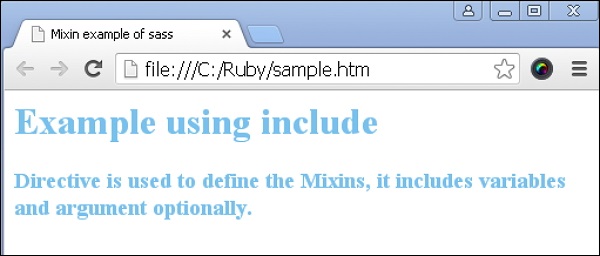
- Sass - Home
- Sass - Overview
- Sass - Installation
- Sass - Syntax
- Using Sass
- Sass - CSS Extensions
- Sass - Comments
- Sass - Script
- Sass - @-Rules and Directives
- Control Directives & Expressions
- Sass - Mixin Directives
- Sass - Function Directives
- Sass - Output Style
- Extending Sass
Sass - Defining a Mixin
Description
The @mixin directive is used to define the mixins. It includes optionally the variables and argument after the name of the mixin.
Example
The following example demonstrates the use of @mixin in the SCSS file −
sample.htm
<html>
<head>
<title> Mixin example of sass</title>
<link rel = "stylesheet" type = "text/css" href = "sample.css"/>
</head>
<body>
<div class = "cont">
<h1>Example using include</h1>
<h3>Directive is used to define the Mixins, it includes variables and argument optionally.</h3>
</div>
</body>
</html>
Next, create file sample.scss.
sample.scss
@mixin style {
.cont{
color: #77C1EF;
}
}
@include style;
You can tell SASS to watch the file and update the CSS whenever SASS file changes, by using the following command −
sass --watch C:\ruby\lib\sass\sample.scss:sample.css
Next, execute the above command; it will create the sample.css file automatically with the following code −
sample.css
.cont {
color: #77C1EF;
}
Output
Let us carry out the following steps to see how the above given code works −
Save the above given html code in sample.htm file.
Open this HTML file in a browser, an output is displayed as shown below.

sass_mixin_directives.htm
Advertisements